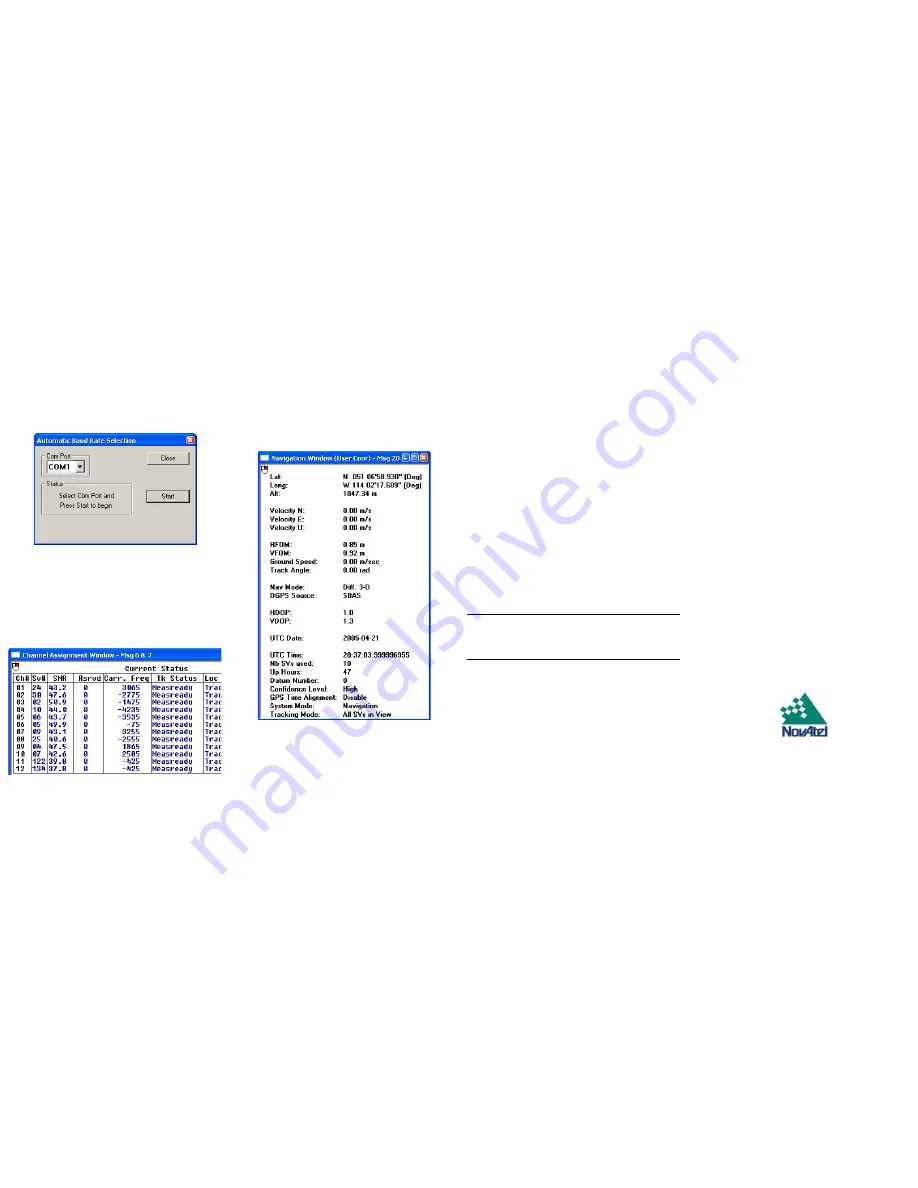
3.
Select the PC serial port the SMART ANTENNA is
connected to from the
Com Port
drop-down list.
4.
Click on
Start
and
StarView
searches for the SMART
ANTENNA on the specified port at various baud rates.
USING STARVIEW
StarView
provides access to key information about your receiver
and its position. The information is displayed in windows
accessed from the
Window
menu. For example, to show details
of the GPS satellites being tracked, select
Channel | Channel
Assignment
from the
Window
menu. Then in the window, right-
click with your mouse and select Continuous or One Shot:
Similarly, select
Navigation | LLH Solution
from the
Window
menu and right-click to select Continuous or One Shot. The
position of the receiver is displayed in LLH (latitude, longitude
and height) coordinates.
DETERMINING WHEN THE POSITION IS VALID
The receiver is in Navigation mode whenever sufficient satellite
information and measurement data is available to produce a
GPS fix. When the receiver has a valid position, the Nav Mode
field in
StarView
’s
LLH Solution,
or
XYZ Solution,
window shows
Nav 3-D, Nav 2-D, Diff. 3-D or Diff. 2-D. If it shows Initialized or
Initialization Required there is no valid position yet.
ENTERING COMMANDS
The SMART ANTENNA uses a comprehensive command
interface. Logs and commands can be sent to the receiver using
the
Xmit Msg
and
Tool Setting
menus in
StarView
.
The following information is important when selecting
commands:
1.
You can send a message request using one shot (Normal
mode) or continuous (Special mode) by selecting
Xmit Msg |
General Message Request
in
StarView.
Refer to the
SUPERSTAR II Firmware Reference Manual,
which shows
how these modes effect individual commands and log
requests differently.
2.
There is an option in
StarView
to save all messages
transmitted by the receiver into a file. Select
File/Port | Save
Data
after you have finished selecting messages in Step #2
above.
The
SUPERSTAR II Firmware Reference Manual
provides details
on messages and parameters that the SMART ANTENNA uses. It
is available on our website at:
http://www.novatel.com/Downloads/docupdates.html
ENABLING SBAS POSITIONING
SMART ANTENNAS are available with an SBAS option. The
ability to simultaneously track two SBAS satellites, and
incorporate the SBAS corrections into the position, is available
on these models.
To enable SBAS, select Tool Setting | DGPS Config in
StarView
.
Set the DGPS Type to SBAS only or Automatic. The receiver
uses SBAS satellites in your coverage area.
Select Window | Status | SBAS Status to view the status of the
SBAS messages. It shows the number of valid SBAS messages
that are being decoded for a specific SV number. When the
Valid
Messages
count is not incrementing, the receiver is not tracking
any SBAS satellites.
When SBAS corrections are incorporated, the LLH solution
shows a Nav Mode of Diff. 3-D and a DGPS Source of SBAS.
StarView
allows you to deselect GPS or SBAS system satellites.
Select Tool Setting | Deselect | SVs from the main menu.
Select Tool Setting | Set Configuration to update receiver
configuration parameters such as maximum velocity, antenna
type and navigation rate.
Refer to the
SUPERSTAR II Firmware Reference Manual
for an
appendix on SBAS Positioning that includes an explanation of
dynamic modes.
QUESTIONS OR COMMENTS
If you have any questions or comments regarding your SMART
ANTENNA, please contact NovAtel Customer Service using one
of the methods provided below.
Email:
Web:
www.novatel.com
Phone: 1-800-NOVATEL (U.S. & Canada)
403-295-4900 (International)
Fax: 403-295-4901
© Copyright 2003-2005 NovAtel Inc. All rights reserved.
Printed in Canada on recycled paper.
Unpublished rights reserved under international copyright laws. Recyclable.
GM-14915053
Rev 5
May 14, 2005


